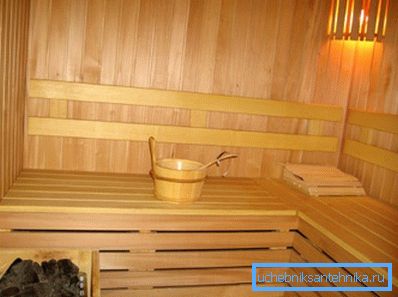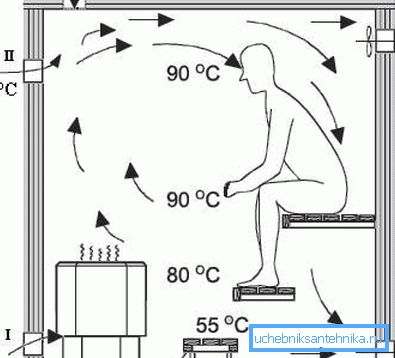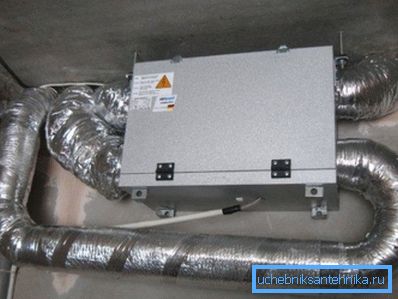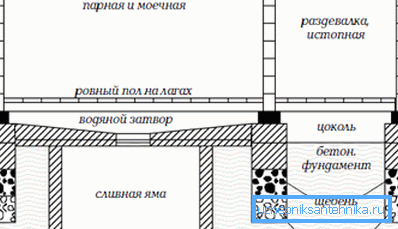Ventilation in the sauna: the choice of a suitable option
In this article we will talk about whether ventilation is necessary in the sauna and why it is needed there. In addition, we consider the main types of ventilation systems that can be used in such premises. Well and, of course, we will consider the actual ways of building such systems with our own hands.

general information
Despite the fact that the steam room was originally designed to provide an extreme microclimate, it is still necessary to do without ventilation. The fact is that the inflow of fresh air is necessary both for the normal well-being of visitors and for the operation of special heating equipment (see also the article Profile pipe: how to determine the quality of the rolled metal by its weight).
However, the ventilation of the sauna and steam rooms by the principle of action is significantly different from the systems used in ordinary residential premises. Fresh air supply in saunas is carried out cyclically, and the mixing of fresh air with heated air proceeds smoothly.
In this case, correct calculations are particularly important, due to which ventilation will ensure optimum air quality without discomfort for visitors. So, what are the features of the device and the functioning of air supply systems from outside to the steam room?
Device and types of current systems

Not enough experienced sauna builders do not understand the importance of arranging fresh air systems.
The price of such neglect results in the following disadvantages:
- air stagnation and increase in moisture content, which for obvious reasons is unacceptable;
- uneven distribution of heat and, as a result, uneven heating of the room;
- the appearance of mold and other harmful microorganisms, which are not allowed in the steam room.
To solve these problems allows efficient ventilation of baths and saunas.
Currently, there are two schemes widely used:
- The first scheme works due to the influx of fresh air, organized in the immediate vicinity of the heating unit (behind the stove). The inlet nozzle is located at the level of the floor plinth and is covered with a decorative grille.

Two exhaust pipes are used at once, one of which is mounted under the ceiling, and the second in the center of the wall. Exhaust pipes are located on the wall opposite the inlet pipes.
Important: For ease of implementation of the project, the exhaust pipes can be connected to a single exhaust channel.

The operation of the system is simple:
- cool air, entering the room near the stove, warms up and rises up;
- due to the gradual movement to the exhaust nozzles, the air warms up the room, and then is discharged outside with excess moisture;
- the system not only provides the room with fresh air, but also guarantees high quality uniform heating.

- The second scheme works on a completely different principle. The device of ventilation in the sauna in this case involves the installation of a fresh air duct approximately at the level of the heating unit.
The outlet duct is mounted about half a meter below the inlet. The location of the pipes, as well as in the previous scheme, is opposite each other.
According to statistics, the first scheme allows for an hour to change the air in the room up to five times. The second scheme allows for one hour to produce twice as many cycles of change of air.
Important: It is impractical to locate the intake and exhaust ducts on the same level. Such a solution will either create a draft, or even stop the air flow altogether.
The previously discussed first and second ventilation scheme in the sauna works according to the natural principle.
The performance of such systems is largely determined not only by the correctness of the design and installation of air ducts, but also by the climatic parameters of the environment. In other words, if there is a minus temperature outside the building, the output of heated air from the room will be intense.
On the other hand, with the onset of the warm season, the situation changes drastically and the intensity of replacing used air with fresh air drops. The question arises how to make the air renewal system in the steam room less dependent on environmental factors?
Forced action schemes

All the disadvantages inherent in schemes based on natural influx are eliminated in the schemes of compulsory action. In other words, forced ventilation in the sauna does not depend on the vicissitudes of the weather outside the building and allows normalizing the internal microclimate in accordance with one or other preferences.
A simple scheme of forced ventilation provides for the installation of a mechanized hood in the upper part of the steam room. The exhaust air will go up, while the replacement of it from the gap at the bottom of the door porch in small portions will receive colder air.
Currently, in specialized stores you can buy built-in fans with an electronic control unit. By purchasing such a device, you can ensure periodic operation of the system, based on the required number of air mixture update cycles.
More complex schemes involve the use of forced exhaust combined with floor ventilation. Considering that the forced circuit works when the fan is turned on, there will be no draft due to the movement of warm and cold flows.
The operating conditions of the steam room will be especially comfortable when a fan with a check valve is used as an exhaust hood. In this case, the air will go out, but will not go in through the hood and, as a result, the heated room will not cool down.
Floor ventilation

After we have reviewed the schemes that work with the use of air ducts and hoods, consider how the floor ventilation is arranged and how such a system can be combined with the previously described systems. The ventilation norms in the sauna will be complied with if the floor ventilation system is arranged in the room.
During the operation of the steam room, excessive moisture is deposited on the floor. If this moisture is not removed in a timely manner, the wood used in the floor construction will deteriorate. That is why saunas in which floor ventilation is not used require repair of the flooring every 3-5 years.
The device of ventilation of a floor of a sauna is carried out at a stage of production of the base. For these purposes, small vents are installed in opposite sides of the basement below the floor level. The vents are closed with nets to allow rodents to enter them.
At this stage, below the level of the outlet, a rough floor is made with a drain for diverting water. When laying the finishing (flowing) floor between the boards, a millimeter gap is made, through which moisture will escape, and fresh air will penetrate at the same time. This ventilation scheme is perfectly combined with forced exhaust, mounted in the upper part of the room.
Conclusion
So, we gave an exhaustive answer to the question of how to make ventilation in the sauna. You just need to purchase pipes of the appropriate diameter with related accessories and assemble the system that will ensure an adequate level of comfort in the steam room (read also the article Pipe bender or machine for rolling a profile pipe with your own hands).
After the ventilation in the sauna with an electric stove or with a conventional stove is arranged, test its performance by bringing the flame of a candle or lighter to the hood. More useful and interesting information can be found by watching the video in this article.